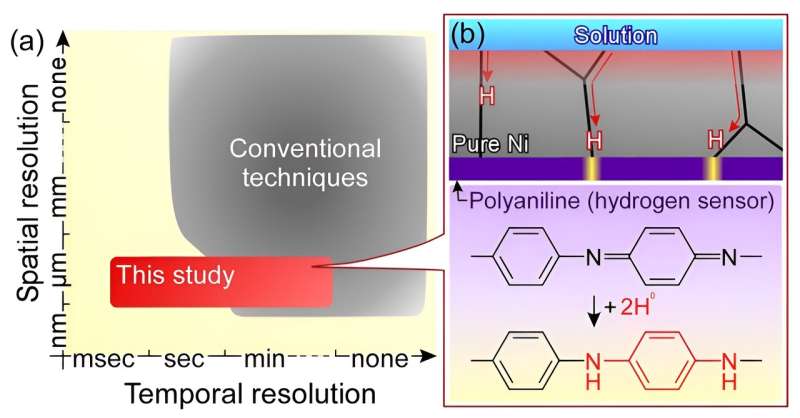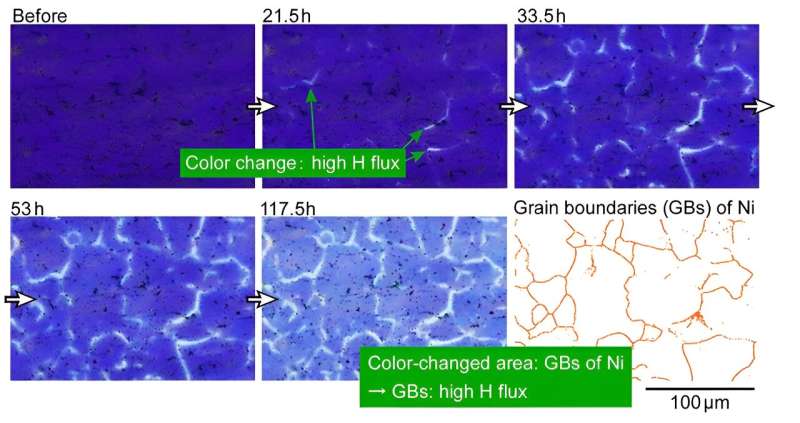This article has been reviewed according to Science X's editorial process and policies. Editors have highlighted the following attributes while ensuring the content's credibility:
fact-checked
peer-reviewed publication
trusted source
proofread
Filming the microscopic flow of hydrogen atoms in a metal

A group of researchers has created a simple and inexpensive means to visualize the atomic state of hydrogen. Details of their breakthrough are published in the journal Acta Materialia.
Hydrogen is carbon dioxide free, and it has long been touted as a source of clean energy. Yet, shifting society toward hydrogen energy requires overcoming some significant technical issues. Structural and functional materials that produce, store, transport and preserve hydrogen are needed.
To develop advanced materials for hydrogen-related applications, a fundamental understanding of how hydrogen behaves in alloys is crucial. However, current technology falls short in this area. Detecting atomic state hydrogen—the smallest atom in the universe—with X-rays or lasers is challenging due to its unique characteristics. Researchers are currently focusing on better analytical and visualization techniques that can incorporate high spatial and time resolutions simultaneously.
Hiroshi Kakinuma, an assistant professor at Tohoku University, and his co-authors developed a new visualization technique harnessing an optical microscope and polyaniline layer.
"When the color of the polyaniline layer reacts with the atomic state hydrogen in metals, it changes colors, allowing us to analyze the flow of hydrogen atoms based on the color distribution of the polyaniline layer," says Kakinuma.
"Additionally, optical microscopes can observe the sub-millimeter-scale view with microscale spatial resolution in real time, thereby capturing hydrogen behavior with unprecedented high spatial and time resolutions."
Thanks to this method, the researchers successfully filmed the flow of hydrogen atoms in pure nickel (Ni). The color of polyaniline changed from purple to white when reacting with hydrogen atoms in a metal. In situ visualization revealed that hydrogen atoms in pure Ni preferentially diffused through grain boundaries in disordered Ni atoms.
Furthermore, the group found that hydrogen diffusion was dependent on the geometrical structure of the grain boundaries: the hydrogen flux grew at grain boundaries with large geometric spaces. These results experimentally clarified the relationship between the atomic-scale structure of pure Ni and the hydrogen diffusion behavior.

The approach has broader applications as well. It can be applied to other metals and alloys, such as steels and aluminum alloys, and drastically facilitates elucidating the microscopic hydrogen-material interactions, which could be further investigated through simulations.
"Understanding hydrogen behaviors related to the atomic-scale structure of alloys will enable efficient alloy design, which will dramatically accelerate the development of highly functional materials and usher us one step closer to a hydrogen energy-based society," adds Kakinuma.
More information: Hiroshi Kakinuma et al, In situ visualization of misorientation-dependent hydrogen diffusion at grain boundaries of pure polycrystalline Ni using a hydrogen video imaging system, Acta Materialia (2023). DOI: 10.1016/j.actamat.2023.119536
Journal information: Acta Materialia
Provided by Tohoku University





















